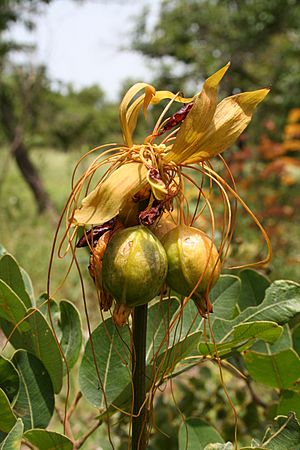Polynesian arrowroot facts for kids
Quick facts for kids Polynesian arrowroot |
|
|---|---|
 |
|
| Scientific classification | |
| Genus: |
Tacca
|
| Species: |
leontopetaloides
|
| Synonyms | |
|
|
Tacca leontopetaloides is a species of flowering plant in the yam family Dioscoreaceae. It is native to Island Southeast Asia but have been introduced as canoe plants throughout the Indo-Pacific tropics by Austronesian peoples during prehistoric times. They have become naturalized to tropical Africa, South Asia, northern Australia, and Oceania. Common names include Polynesian arrowroot, Fiji arrowroot, East Indies arrowroot, and pia.
History of cultivation
Polynesian arrowroot is an ancient Austronesian root crop closely related to yams. It is originally native to Island Southeast Asia. It was introduced throughout the entire range of the Austronesian expansion during prehistoric times (c. 5,000 BP), including Micronesia, Polynesia, and Madagascar. Polynesian arrowroot have been identified as among the cultivated crops in Lapita sites in Palau, dating back to 3,000 to 2,000 BP. It was also introduced to Sri Lanka, southern India, and possibly also Australia through trade and contact.
Polynesian arrowroot was a minor staple among Austronesians. The roots are bitter if not prepared properly, thus it was only cultivated as a secondary crop to staples like Dioscorea alata and Colocasia esculenta. Its importance increased for settlers in the Pacific Islands, where food plants were scarcer, and it was introduced to virtually all the inhabited islands. They were valued for their ability to grow in low islands and atolls, and were often the staple crops in islands with these conditions. In larger islands, they were usually allowed to grow feral and were useful only as famine food. Several cultivars have been developed in Polynesia due to the centuries of artificial selection. The starch extracted from the root with traditional methods can last for a very long time, and thus can be stored or traded. The starch can be cooked in leaves to make starchy puddings, similar to the use of starch extracted from sago palms (Metroxylon sagu). Due to the introduction of modern crops, it is rarely cultivated today.
Description
Several petioles 17–150 cm (6.7–59.1 in) in length extend from the center of the plant, on which the large leaves (30–70 cm or 12–28 in long and up to 120 cm or 47 in wide) are attached. The leaf's upper surface has depressed veins, and the under surface is shiny with bold yellow veins. Flowers are borne on tall stalks in greenish-purple clusters, with long trailing bracts. The plant is usually dormant for part of the year and dies down to the ground. Later, new leaves will arise from the round underground tuber. The tubers are hard and potato-like, with a brown skin and white interior.
Uses
The tubers of Polynesian arrowroot contain starch, making it an important food source for many Pacific Island cultures, primarily for the inhabitants of low islands and atolls. Polynesian arrowroot was prepared into a flour to make a variety of puddings. The tubers were first grated and then allowed to soak in fresh water. The settled starch was rinsed repeatedly to remove the bitterness and then dried. The flour was mixed with mashed taro, breadfruit, or Pandanus fruit extract and mixed with coconut cream to prepare puddings. In Hawaii, a local favorite is haupia, which was originally made with pia flour, coconut cream and kō (cane sugar). Today, Polynesian arrowroot has been largely replaced by cornstarch.
The starch was additionally used to stiffen fabrics, and on some islands, the stem's bast fibres were woven into mats.
In traditional Hawaiian medicine the raw tubers were eaten to treat stomach ailments. Mixed with water and red clay, the plant was consumed to treat diarrhea and dysentery. This combination was also used to stop internal hemorrhaging in the stomach and colon and applied to wounds to stop bleeding.

